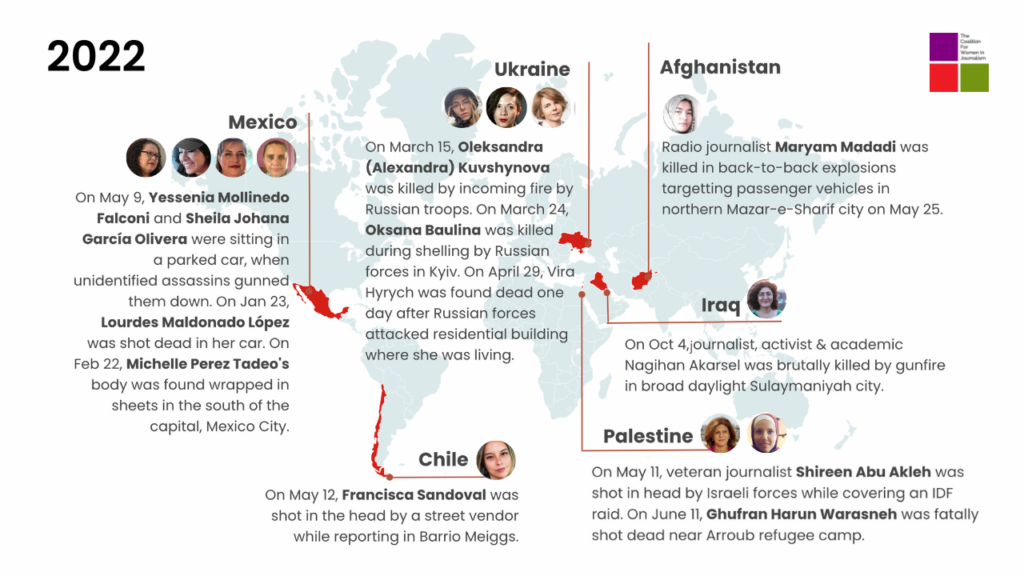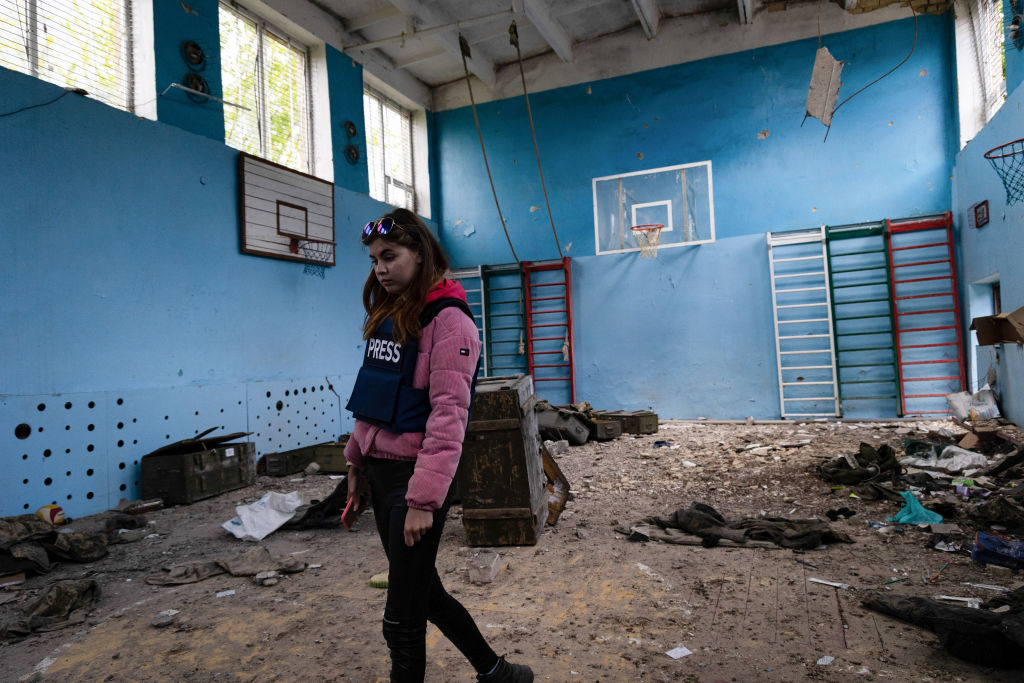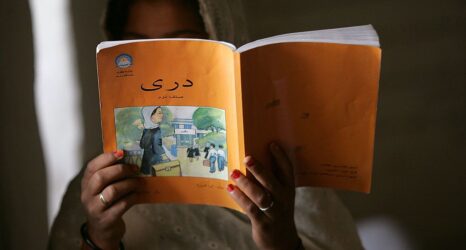Last year marked the highest number of murdered and imprisoned women journalists in a single year.

2022 has taken its toll on the full range of women journalists’ rights. In 2022, we witnessed a war, the uprising of women in a country, the arrest of women journalists, and the deprivation of a vast number of women’s rights, including education, and much more.
Among all of these major events, an unprecedented number of female journalists were killed while doing their jobs. Many were arrested for exposing facts while numerous others were targeted by online troll campaigns, a form of harassment that is experienced exclusively by women in the profession. In 2022, the safety of women in the media industry diminished significantly.
Twelve women journalists were murdered in 2022.

This is the highest number of women journalists killed in a single year since the CFWIJ began documenting violence against women journalists around the world in 2017. Four murders occurred in Mexico, making it the country with the highest number of female journalists killed in 2022, followed by three murders in Ukraine, two in Palestine, and one each in Iraq, Chile and Afghanistan.

Following the eruption of protests in Iran over the death of Mahsa Amini, the number of imprisoned female journalists in the world increased by 64 percent.
Although some have been released, at least 104 women journalists still await liberation, 64 of whom were arrested in 2022 alone. In the five years since the CFWIJ began documenting incidents of violence against women journalists, this is the highest number of imprisonments recorded in a single year.

With 35 documented arrests in their country in 2022, Iran is currently the top jailer of women journalists.
Women journalists reported on war from the frontlines.

On Feb. 24, 2022, following weeks of escalating tensions, Russia launched a full-scale military invasion of Ukrainian territory. The military operation comes amid growing NATO influence in the Eastern European region and increasing Western sanctions imposed on Russia to deter its state from escalating against Ukraine. After several months of failed diplomatic engagements, President Vladimir Putin announced an “operation” to “protect people who have been subjected to abuse and genocide by the Kyiv regime for eight years.”
As the Russian invasion forces continue to make advances in Ukraine, several media workers in the country, local and foreign, have come under attack, and three women journalists have been killed.
On March 14, Fox News Ukrainian journalist Oleksandra (Alexandra) Kuvshynova and camera operator Pierre Zakrzewski were killed by incoming fire from Russian troops near the village of Horenka, outside Kyiv.
On March 24, Oksana Baulina, a reporter for the independent Latvia-based investigative news website The Insider, lost her life amid a Russian offensive against the Ukrainian capital, Kyiv. The incident took place in Kyiv’s Podilskyi district, where she was present to report on Russian shelling.
On April 29, Vira Hyrych, a journalist working for Radio Free Europe/ Radio Liberty (RFE/RL) in Kyiv, was found dead one day after Russian forces attacked the residential building where she was living in the Ukrainian capital.
In Russia, at least 35 female reporters were subjected to violations such as detention, legal harassment and abduction. 20 were detained for covering anti-war rallies against Russia’s invasion of Ukraine across the country, and at least five women journalists were targeted by the state through legislation.
On June 17, Russia banned six women journalists from the United Kingdom from entering the country, claiming they were “involved in the deliberate dissemination of false and one-sided information”. The complete list issued by Kremlin authorities names 49 prominent figures from the UK, including 29 journalists, who have been blacklisted.
Iran is the biggest jailer of women journalists.
Almost all of my press colleagues from the newspaper are now living away from their homes. There is a very real fear of arrest and intimidation for them even if journalists are not reporting at the moment. Those of us who have children, want to be safe not for ourselves but our children.
Iranian journalist M.V.
In 2022, after years of fighting for their rights, women ignited the first spark of a revolution in Iran. Protests broke out all over the country following the murder of Mahsa Amini on Sept. 16, 2022, and women journalists who have been following the protests are being targeted by authorities who wish to silence them.
At least 25 women have been arrested for reporting on the situation since the protests began on Sept. 16, increasing the total number of female journalists incarcerated in Iran in 2022 from 10 to 35. While there have been at least five releases, Iran is the top jailer of women journalists around the world in 2022.
It’s been both hard and uplifting to be in touch with courageous #womenjournalists in #iran. Here’s what one of them told @CFWIJ this week. A reminder that #iran is one of the biggest jailers for #womenjournalists and activists, but these women are tough women! #freeThePress pic.twitter.com/5ARtw5cbI8
— Kiran Nazish (@kirannazish) September 26, 2022
The CFWIJ has been closely monitoring the situation on the ground, as well as the threats and abuse aimed at journalists in Iran that come from outside of the country. Our sources have informed us that numerous journalists were arrested by the Islamic Republic immediately after Mahsa Amini was killed, and this procedure continues until today. Journalists in Iran have told us that they are followed by unidentified men, often before being detained and interrogated.
It is currently very difficult to gain access to clear communication in Iran. Following their arrest, many journalists are not allowed to make phone calls to either their lawyers or their families, and authorities often provide incorrect information to relatives and legal representatives who inquire about their location. This sort of misinformation is such a usual occurrence that most sources who contact the CFWIJ believe it is being done deliberately to misguide the families and cause further distress.
To make matters worse, the internet is blocked in many areas of the country, which has severely limited the ability of many journalists and activists to request aid. Many female journalists across different cities in Iran have gone into hiding, but the CFWIJ recognizes that not all journalists have the option of seeking shelter with family or friends. The well-being of female journalists in Iran, especially those who have nowhere to hide, is at great risk.
In Afghanistan, amidst escalating threats and growing fear, women prove resilient.
Since Kabul fell to the Taliban in 2021, the CFWIJ has received an influx of pleas for help from Afghan journalists and activists. The majority of these requests for aid come from women, many of whom are at high risk under the new Taliban regime. The threatened, yet resilient, Afghan women journalists shared stories of despair, fear and silence. The
Afghan media, which once thrived even amidst the worst of threats such as murder and imprisonment, is now struggling to survive under Taliban rule. In 2022, the CFWIJ has evacuated and assisted more than 450 journalists, women leaders and activists from Afghanistan to safety.
The Taliban takeover has crushed many of the dreams that Afghan women have been working towards for the last two decades, and journalists have risked their lives to provide an account of the war crisis and the atrocities taking place under Taliban rule. They have shown courage in the face of fear, intimidation and threats of violence, but a tragic number of journalists have been severely injured and even lost their lives while reporting on the situation in Afghanistan.
Radio journalist Maryam Madadi was among nine killed in a series of explosions that hit the northern city of Mazar-e-Sharif on May 25, 2022. Three passenger buses carrying members of the Hazara and Shia communities were targeted with explosives placed inside the vehicles. ISIS later claimed responsibility for the attacks, in which at least 15 people were wounded, in addition to the nine lives lost.
Two women journalists were deported from Afghanistan by the Taliban in 2022. Upon her arrival in Kabul in May, VICE’s award-winning journalist Isobel Young was forbidden to leave her hotel by Taliban authorities, who told her that she was not allowed to work in Kabul, and ordered her to leave the country “immediately.” In October, photographer and independent reporter Stefanie Glinski was deported from Afghanistan by Taliban authorities and denied re-entry into the country.
On July 23, Australian journalist Lynne O’Donnell was forced by Taliban authorities to denounce the integrity of her work and apologize for her reporting. O’Donnell, a columnist at Foreign Policy, was called in for questioning by the general directorate of intelligence only one day after her arrival in Kabul. Intelligence officers threatened to prevent her from leaving the country unless she submitted to questioning, then detained her for hours and warned her that she would face imprisonment unless she tweeted an apology for her “inaccurate” reporting on forced marriages of women and girls to Taliban commanders.
On Nov. 3, the Taliban arrested journalist and human rights activist Zarifa Yaqoubi, along with other women reporters who were attending a press conference in Dasht-e-Barchi, a settlement in western Kabul. According to sources, the Taliban disrupted the press conference which was being held to announce the formation of the Afghan Women’s Movement for Equality, and arbitrarily arrested women journalists and activists, who were then taken to an undisclosed location.
Women face increasing risks while reporting from Turkey.
In 2022, the CFWIJ noted with concern the increasingly dangerous terrain that women journalists in Turkey have had to navigate, both physically and digitally, in order to continue doing their jobs.
Between January and December 2022, we recorded 150 cases of violations against women journalists. The state has routinely weaponized its institutions to target them. At least 50 women have faced legal persecution, while 47 have been assaulted in the field by either the police force or supporters of the state.
The number of women journalists detained in Turkey has increased by 27 percent in the last year. Turkey, which ranks first in many violence categories, seems to have set a new record. Women journalists have also been targeted through organized online troll campaigns and through state media for criticizing government policies. Despite these attempts to silence them, women journalists in Turkey continue to fulfil their civic role of holding power accountable.
Currently, Turkey is the country with the most cases of physical violence against women journalists documented by the CFWIJ in 2022. On Oct. 25, 11 journalists, including seven women, were detained and physically assaulted after their homes were raided by Turkish police. Six of them were arrested and, in a single day, the country jumped from fifth to third place in the CFWIJ’s ranking of the top jailers of women journalists in 2022. As of Dec. 31, 2022, 17 women journalists are imprisoned in Turkey.
Online violence is another tactic used to attack and intimidate journalists around the world, but this form of harassment is not seen as real violence in Turkey. Female journalists seem to be the preferred target of online abuse, which is especially prevalent on various social media platforms. The threats of death and rape that are aimed at these women can often reach extreme levels of brutality, but are disregarded by Turkish authorities, despite the fact that they pose a very real danger to the women’s lives. Journalists who are openly threatened online become vulnerable to attacks while reporting in the field.
Since January 2022, at least eight Turkish women journalists have been subjected to major online trolling campaigns. Artı Gerçek reporter Seda Taşkın became the target of online death threats on May 13, 2022. Comments such as, “I’m on your neck wherever you are,” and “Death will find you,” were posted to her Instagram page by an unidentified account.
In some cases, smear campaigns against women journalists have been started by Turkish politicians as an intimidation tactic to diverge attention from their dubious political endeavors. On May 5, 2022, at least four female reporters became the targets of one of these campaigns after the right-wing Zafer (Victory) Party shared an anti-refugee short film on Youtube called “Silent Invasion”, inciting its supporters to attack the women online. Journalists Nevşin Mengü, Burcu Karakaş, Suzan Demir, Neşe İdil, and lawyer and columnist İpek Maya Saygın were among the targets of the hate campaign, which weaponized racist and misogynistic language to threaten, intimidate, and censor the journalists.
This smear campaign tactic has been adopted by some of the Mafia heads that are frequently sighted in Turkey. On May 19, far-right mafia leader Allaattin Çakıcı started a smear campaign against journalists Hale Gönültaş and Seyhan Avşar, which encouraged other extremists to attack the women online. The gender-based online violence experienced by women in the media is an issue that must be taken seriously by authorities not only in Turkey, but around the world.
This story was originally published by The Coalition for Women in Journalism. Read their full 2022 Annual Press Freedom Review here.
Up next:
U.S. democracy is at a dangerous inflection point—from the demise of abortion rights, to a lack of pay equity and parental leave, to skyrocketing maternal mortality, and attacks on trans health. Left unchecked, these crises will lead to wider gaps in political participation and representation. For 50 years, Ms. has been forging feminist journalism—reporting, rebelling and truth-telling from the front-lines, championing the Equal Rights Amendment, and centering the stories of those most impacted. With all that’s at stake for equality, we are redoubling our commitment for the next 50 years. In turn, we need your help, Support Ms. today with a donation—any amount that is meaningful to you. For as little as $5 each month, you’ll receive the print magazine along with our e-newsletters, action alerts, and invitations to Ms. Studios events and podcasts. We are grateful for your loyalty and ferocity.





